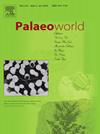Climate and vegetation changes in southern Primorye (Russian Far East) since the Last Glacial Maximum: A quantitative analysis
IF 1.7
3区 地球科学
Q2 PALEONTOLOGY
引用次数: 0
Abstract
The climate and vegetation for southern Primorye during the last 21 kyr are studied for the first time in detail using quantitative techniques on high-temporal resolution pollen record. The data obtained showed a clear relationship with global climate events: Last Glacial Maximum, Heinrich 1, Bølling/Allerød, Younger Dryas and the warmest climate event around ca. 8.0 ka. A moderate monsoon-type climate persisted in Primorye during the last 21 kyr. The mean annual temperature did not fall below 0°C. The magnitude of the glacial–interglacial mean temperature difference in southern Primorye was ca. 7°C. Cold and cool temperate climate existed between ca. 21.0 and 11.6 ka and after 4.3 ka respectively. Climate variables of the Last Glacial Maximum were slightly below present-day values, and drier conditions prevailed compared to the late Holocene. Moderately cool conditions with excessive moisture existed during the cold events of the late Pleistocene, i.e., Younger Dryas and Heinrich 1, and in the late Holocene. Humidification did not occur due to heavy rainfall, but due to less evaporation because of low average annual temperatures during these cold events. During the last 21 kyr, there existed dry and wet seasons in Primorye, as at present, associated with monsoon circulation. The summer monsoon was more intense at ca. 16.6 ka, 14.4 ka, 11.6 ka and from ca. 11.0 to 4.3 ka.
The southern Primorye during last 21 kyr had a diverse spatial vegetation pattern with conifer and broadleaved deciduous forests of warmer or colder temperate type, dry and humid grasslands, open woodlands and riparian vegetation. Both today and in the past, the heterogeneity of the relief and climate created a diverse vegetation cover. The warmest component, broadleaved summergreen warm temperate trees, had a high proportion from 10.4 to 4.6 ka. Late Pleistocene plant communities, especially during the Last Glacial Maximum, were characterized by a high diversity of dry herbs, which indicates a dry steppe. There are indications of forest-steppe during LGM based on PFT and IPR analyses.
末次冰川极盛时期以来滨海南部(俄罗斯远东地区)的气候和植被变化:定量分析
利用高时间分辨率花粉记录的定量技术,首次详细研究了滨海南部过去 21 千年的气候和植被。获得的数据显示了与全球气候事件的明显关系:这些气候事件包括:末次冰川极盛期、海因里希 1 号、伯林/阿勒罗德、少干 旱期以及约 8.0 ka 前后的最暖气候事件。在过去的 21 千年里,滨海地区一直是温和的季风型气候。年平均气温不低于 0°C。滨海南部冰川期与间冰期的平均温差约为 7°C。寒带和温带气候分别存在于约 21.0 至 11.6 ka 期间和 4.3 ka 之后。末次冰川极盛时期的气候变量略低于现今的数值,与全新世晚期相比,当时的气候条件较为干燥。在更新世晚期的寒冷事件(即杨格干 旱期和海因里希 1 期)以及全新世晚期,气候温和凉爽,湿度过大。加湿现象的出现并不是因为降雨量大,而是因为这些寒冷事件期间年平均气温较低,导致蒸发量减少。在过去的 21 千年里,滨海地区与现在一样,存在着与季风环流相关的旱季和雨季。夏季季风在大约 16.6 ka、14.4 ka 和 16.6 ka 时更为强烈。在大约 16.6 ka、14.4 ka、11.6 ka 以及大约 11.0 ka 至 4.3 ka 期间,夏季季风更为猛烈。
本文章由计算机程序翻译,如有差异,请以英文原文为准。
求助全文
约1分钟内获得全文
求助全文
来源期刊

Palaeoworld
PALEONTOLOGY-
CiteScore
4.00
自引率
5.90%
发文量
95
期刊介绍:
Palaeoworld is a peer-reviewed quarterly journal dedicated to the study of past life and its environment. We encourage submission of original manuscripts on all aspects of palaeontology and stratigraphy, comparisons of regional and global data in time and space, and results generated by interdisciplinary investigations in related fields. Some issues will be devoted entirely to a special theme whereas others will be composed of contributed articles. Palaeoworld is dedicated to serving a broad spectrum of geoscientists and palaeobiologists as well as serving as a resource for students in fields as diverse as palaeobiology, evolutionary biology, taxonomy and phylogeny, geobiology, historical geology, and palaeoenvironment.
Palaeoworld publishes original articles in the following areas:
•Phylogeny and taxonomic studies of all fossil groups
•Biostratigraphy, chemostratigraphy, chronostratigraphy
•Palaeoecology, palaeoenvironment and global changes throughout Earth history
•Tempo and mode of biological evolution
•Biological events in Earth history (e.g., extinctions, radiations)
•Ecosystem evolution
•Geobiology and molecular palaeobiology
•Palaeontological and stratigraphic methods
•Interdisciplinary studies focusing on fossils and strata
 求助内容:
求助内容: 应助结果提醒方式:
应助结果提醒方式:


